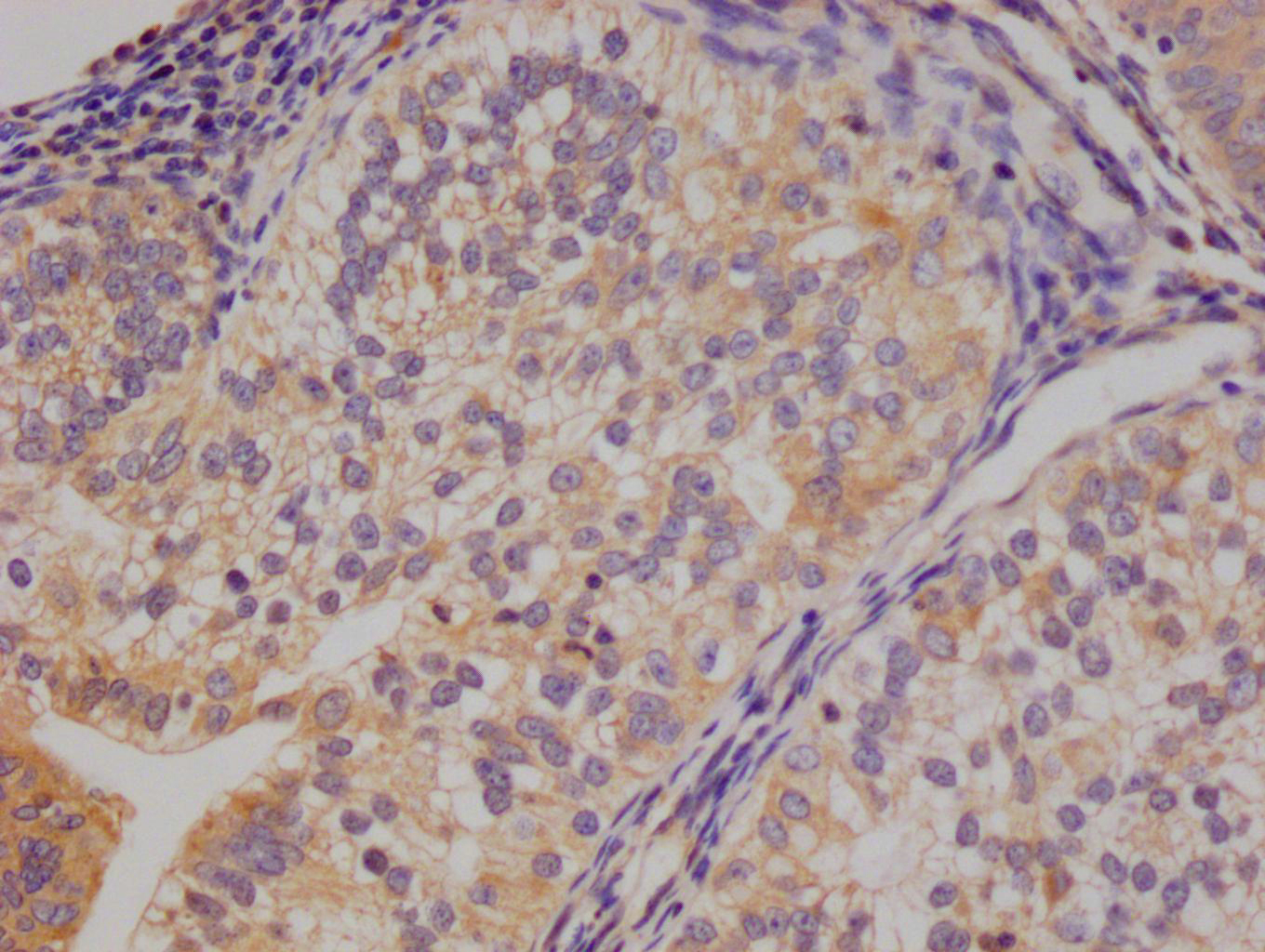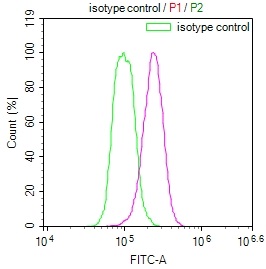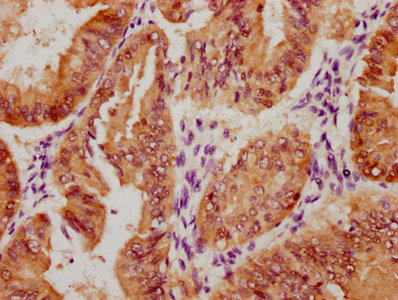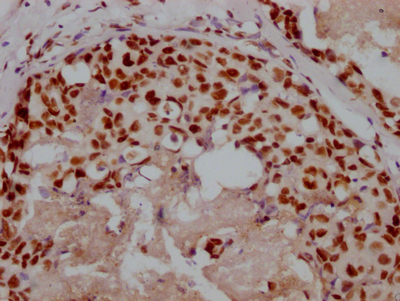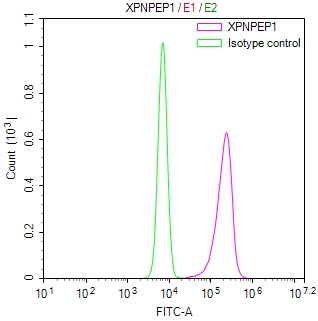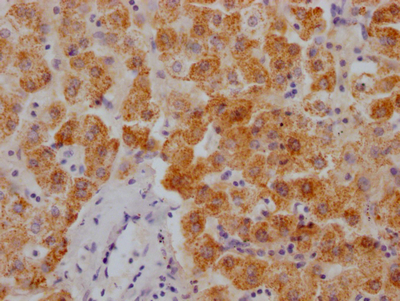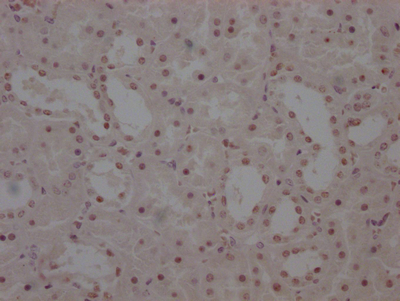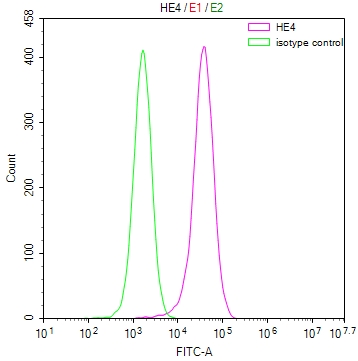-
中文名稱:Genome polyprotein兔多克隆抗體, FITC偶聯
-
貨號:CSB-PA333180LC01HFD
-
規格:¥880
-
其他:
產品詳情
-
產品名稱:Rabbit anti-Hepatitis C virus genotype 1a N/A Polyclonal antibody
-
Uniprot No.:
-
基因名:N/A
-
別名:Genome polyprotein [Cleaved into: Core protein p21 antibody; Capsid protein C antibody; p21); Core protein p19; Envelope glycoprotein E1 antibody; gp32 antibody; gp35); Envelope glycoprotein E2 antibody; NS1 antibody; gp68 antibody; gp70); p7; Protease NS2-3 antibody; p23 antibody; EC 3.4.22.-); Serine protease NS3 antibody; EC 3.4.21.98 antibody; EC 3.6.1.15 antibody; EC 3.6.4.13 antibody; Hepacivirin antibody; NS3P antibody; p70); Non-structural protein 4A antibody; NS4A antibody; p8); Non-structural protein 4B antibody; NS4B antibody; p27); Non-structural protein 5A antibody; NS5A antibody; p56); RNA-directed RNA polymerase antibody; EC 2.7.7.48 antibody; NS5B antibody; p68)] antibody
-
宿主:Rabbit
-
反應種屬:Hepatitis C virus genotype 1a
-
免疫原:Recombinant Hepatitis C virus genotype 1a Genome polyprotein protein (192-325AA)
-
免疫原種屬:Hepatitis C virus genotype 1a
-
標記方式:FITC
-
克隆類型:Polyclonal
-
抗體亞型:IgG
-
純化方式:>95%, Protein G purified
-
濃度:It differs from different batches. Please contact us to confirm it.
-
保存緩沖液:Preservative: 0.03% Proclin 300
Constituents: 50% Glycerol, 0.01M PBS, PH 7.4 -
產品提供形式:Liquid
-
儲存條件:Upon receipt, store at -20°C or -80°C. Avoid repeated freeze.
-
貨期:Basically, we can dispatch the products out in 1-3 working days after receiving your orders. Delivery time maybe differs from different purchasing way or location, please kindly consult your local distributors for specific delivery time.
-
用途:For Research Use Only. Not for use in diagnostic or therapeutic procedures.
相關產品
靶點詳情
-
功能:Packages viral RNA to form a viral nucleocapsid, and promotes virion budding (Probable). Participates in the viral particle production as a result of its interaction with the non-structural protein 5A. Binds RNA and may function as a RNA chaperone to induce the RNA structural rearrangements taking place during virus replication. Modulates viral translation initiation by interacting with viral IRES and 40S ribosomal subunit. Affects various cell signaling pathways, host immunity and lipid metabolism (Probable). Prevents the establishment of cellular antiviral state by blocking the interferon-alpha/beta (IFN-alpha/beta) and IFN-gamma signaling pathways and by blocking the formation of phosphorylated STAT1 and promoting ubiquitin-mediated proteasome-dependent degradation of STAT1. Activates STAT3 leading to cellular transformation. Regulates the activity of cellular genes, including c-myc and c-fos. May repress the promoter of p53, and sequester CREB3 and SP110 isoform 3/Sp110b in the cytoplasm. Represses cell cycle negative regulating factor CDKN1A, thereby interrupting an important check point of normal cell cycle regulation. Targets transcription factors involved in the regulation of inflammatory responses and in the immune response: suppresses TNF-induced NF-kappa-B activation, and activates AP-1. Binds to dendritic cells (DCs) via C1QR1, resulting in down-regulation of T-lymphocytes proliferation. Alters lipid metabolism by interacting with hepatocellular proteins involved in lipid accumulation and storage. Induces up-regulation of FAS promoter activity, and thereby contributes to the increased triglyceride accumulation in hepatocytes (steatosis).; Forms a heterodimer with envelope glycoprotein E2, which mediates virus attachment to the host cell, virion internalization through clathrin-dependent endocytosis and fusion with host membrane. Fusion with the host cell is most likely mediated by both E1 and E2, through conformational rearrangements of the heterodimer required for fusion rather than a classical class II fusion mechanism. E1/E2 heterodimer binds host apolipoproteins such as APOB and APOE thereby forming a lipo-viro-particle (LVP). APOE associated to the LVP allows the initial virus attachment to cell surface receptors such as the heparan sulfate proteoglycans (HSPGs), syndecan-1 (SDC1), syndecan-1 (SDC2), the low-density lipoprotein receptor (LDLR) and scavenger receptor class B type I (SCARB1). The cholesterol transfer activity of SCARB1 allows E2 exposure and binding of E2 to SCARB1 and the tetraspanin CD81. E1/E2 heterodimer binding on CD81 activates the epithelial growth factor receptor (EGFR) signaling pathway. Diffusion of the complex E1-E2-EGFR-SCARB1-CD81 to the cell lateral membrane allows further interaction with Claudin 1 (CLDN1) and occludin (OCLN) to finally trigger HCV entry.; Forms a heterodimer with envelope glycoprotein E1, which mediates virus attachment to the host cell, virion internalization through clathrin-dependent endocytosis and fusion with host membrane. Fusion with the host cell is most likely mediated by both E1 and E2, through conformational rearrangements of the heterodimer required for fusion rather than a classical class II fusion mechanism. The interaction between envelope glycoprotein E2 and host apolipoprotein E/APOE allows the proper assembly, maturation and infectivity of the viral particles. This interaction is probably promoted via the up-regulation of cellular autophagy by the virus. E1/E2 heterodimer binds host apolipoproteins such as APOB and APOE thereby forming a lipo-viro-particle (LVP). APOE associated to the LVP allows the initial virus attachment to cell surface receptors such as the heparan sulfate proteoglycans (HSPGs), syndecan-1 (SDC1), syndecan-1 (SDC2), the low-density lipoprotein receptor (LDLR) and scavenger receptor class B type I (SCARB1). The cholesterol transfer activity of SCARB1 allows E2 exposure and binding of E2 to SCARB1 and the tetraspanin CD81. E1/E2 heterodimer binding on CD81 activates the epithelial growth factor receptor (EGFR) signaling pathway. Diffusion of the complex E1-E2-EGFR-SCARB1-CD81 to the cell lateral membrane allows further interaction with Claudin 1 (CLDN1) and occludin (OCLN) to finally trigger HCV entry. Inhibits host EIF2AK2/PKR activation, preventing the establishment of an antiviral state. Viral ligand for CD209/DC-SIGN and CLEC4M/DC-SIGNR, which are respectively found on dendritic cells (DCs), and on liver sinusoidal endothelial cells and macrophage-like cells of lymph node sinuses. These interactions allow the capture of circulating HCV particles by these cells and subsequent facilitated transmission to permissive cells such as hepatocytes and lymphocyte subpopulations. The interaction between E2 and host amino acid transporter complex formed by SLC3A2 and SLC7A5/LAT1 may facilitate viral entry into host cell.; Ion channel protein that acts as a viroporin and plays an essential role in the assembly, envelopment and secretion of viral particles. Regulates the host cell secretory pathway, which induces the intracellular retention of viral glycoproteins and favors assembly of viral particles. Creates a pore in acidic organelles and releases Ca(2+) and H(+) in the cytoplasm of infected cells, leading to a productive viral infection. High levels of cytoplasmic Ca(2+) may trigger membrane trafficking and transport of viral ER-associated proteins to viroplasms, sites of viral genome replication (Probable). This ionic imbalance induces the assembly of the inflammasome complex, which triggers the maturation of pro-IL-1beta into IL-1beta through the action of caspase-1. Targets also host mitochondria and induces mitochondrial depolarization. In addition of its role as a viroporin, acts as a lipid raft adhesion factor.; Cysteine protease required for the proteolytic auto-cleavage between the non-structural proteins NS2 and NS3. The N-terminus of NS3 is required for the function of NS2 protease (active region NS2-3). Promotes the initiation of viral particle assembly by mediating the interaction between structural and non-structural proteins.; Displays three enzymatic activities: serine protease with a chymotrypsin-like fold, NTPase and RNA helicase. NS3 serine protease, in association with NS4A, is responsible for the cleavages of NS3-NS4A, NS4A-NS4B, NS4B-NS5A and NS5A-NS5B. The NS3/NS4A complex prevents phosphorylation of host IRF3, thus preventing the establishment of dsRNA induced antiviral state. The NS3/NS4A complex induces host amino acid transporter component SLC3A2, thus contributing to HCV propagation. NS3 RNA helicase binds to RNA and unwinds both dsDNA and dsRNA in the 3' to 5' direction, and likely resolves RNA complicated stable secondary structures in the template strand. Binds a single ATP and catalyzes the unzipping of a single base pair of dsRNA. Inhibits host antiviral proteins TBK1 and IRF3 thereby preventing the establishment of an antiviral state. Cleaves host MAVS/CARDIF thereby preventing the establishment of an antiviral state. Cleaves host TICAM1/TRIF, thereby disrupting TLR3 signaling and preventing the establishment of an antiviral state.; The NS3/NS4A complex prevents phosphorylation of host IRF3, thus preventing the establishment of dsRNA induced antiviral state. The NS3/NS4A complex induces host amino acid transporter component SLC3A2, thus contributing to HCV propagation.; Induces a specific membrane alteration that serves as a scaffold for the virus replication complex. This membrane alteration gives rise to the so-called ER-derived membranous web that contains the replication complex. NS4B self-interaction contributes to its function in membranous web formation. Promotes host TRIF protein degradation in a CASP8-dependent manner thereby inhibiting host TLR3-mediated interferon signaling. Disrupts the interaction between STING and TBK1 contributing to the inhibition of interferon signaling.; Phosphorylated protein that is indispensable for viral replication and assembly. Both hypo- and hyperphosphorylated states are required for the viral life cycle. The hyperphosphorylated form of NS5A is an inhibitor of viral replication. Involved in RNA-binding and especially in binding to the viral genome. Zinc is essential for RNA-binding. Participates in the viral particle production as a result of its interaction with the mature viral core protein. Its interaction with host VAPB may target the viral replication complex to vesicles. Down-regulates viral IRES translation initiation. Mediates interferon resistance, presumably by interacting with and inhibiting host EIF2AK2/PKR. Prevents BIN1-induced apoptosis. Acts as a transcriptional activator of some host genes important for viral replication when localized in the nucleus. Via the interaction with host PACSIN2, modulates lipid droplet formation in order to promote virion assembly. Modulates TNFRSF21/DR6 signaling pathway for viral propagation.; RNA-dependent RNA polymerase that performs primer-template recognition and RNA synthesis during viral replication.
-
亞細胞定位:[Core protein precursor]: Host endoplasmic reticulum membrane; Single-pass membrane protein. Host mitochondrion membrane; Single-pass type I membrane protein.; [Envelope glycoprotein E1]: Virion membrane; Single-pass type I membrane protein. Host endoplasmic reticulum membrane; Single-pass type I membrane protein.; [Envelope glycoprotein E2]: Virion membrane; Single-pass type I membrane protein. Host endoplasmic reticulum membrane; Single-pass type I membrane protein. Host lipid droplet.; [Viroporin p7]: Host endoplasmic reticulum membrane; Multi-pass membrane protein. Host mitochondrion. Host cell membrane.; [Protease NS2]: Host endoplasmic reticulum membrane; Multi-pass membrane protein.; [Serine protease/helicase NS3]: Host endoplasmic reticulum membrane; Peripheral membrane protein.; [Non-structural protein 4A]: Host endoplasmic reticulum membrane; Single-pass type I membrane protein.; [Non-structural protein 4B]: Host endoplasmic reticulum membrane; Multi-pass membrane protein.; [Non-structural protein 5A]: Host endoplasmic reticulum membrane; Peripheral membrane protein. Host cytoplasm, host perinuclear region. Host mitochondrion. Host cytoplasm. Host nucleus. Host lipid droplet.; [RNA-directed RNA polymerase]: Host cytoplasm. Host endoplasmic reticulum membrane; Single-pass type I membrane protein.
-
蛋白家族:Hepacivirus polyprotein family
Most popular with customers
-
-
YWHAB Recombinant Monoclonal Antibody
Applications: ELISA, WB, IHC, IF, FC
Species Reactivity: Human, Mouse, Rat
-
Phospho-YAP1 (S127) Recombinant Monoclonal Antibody
Applications: ELISA, WB, IHC
Species Reactivity: Human
-
-
-
-
-


